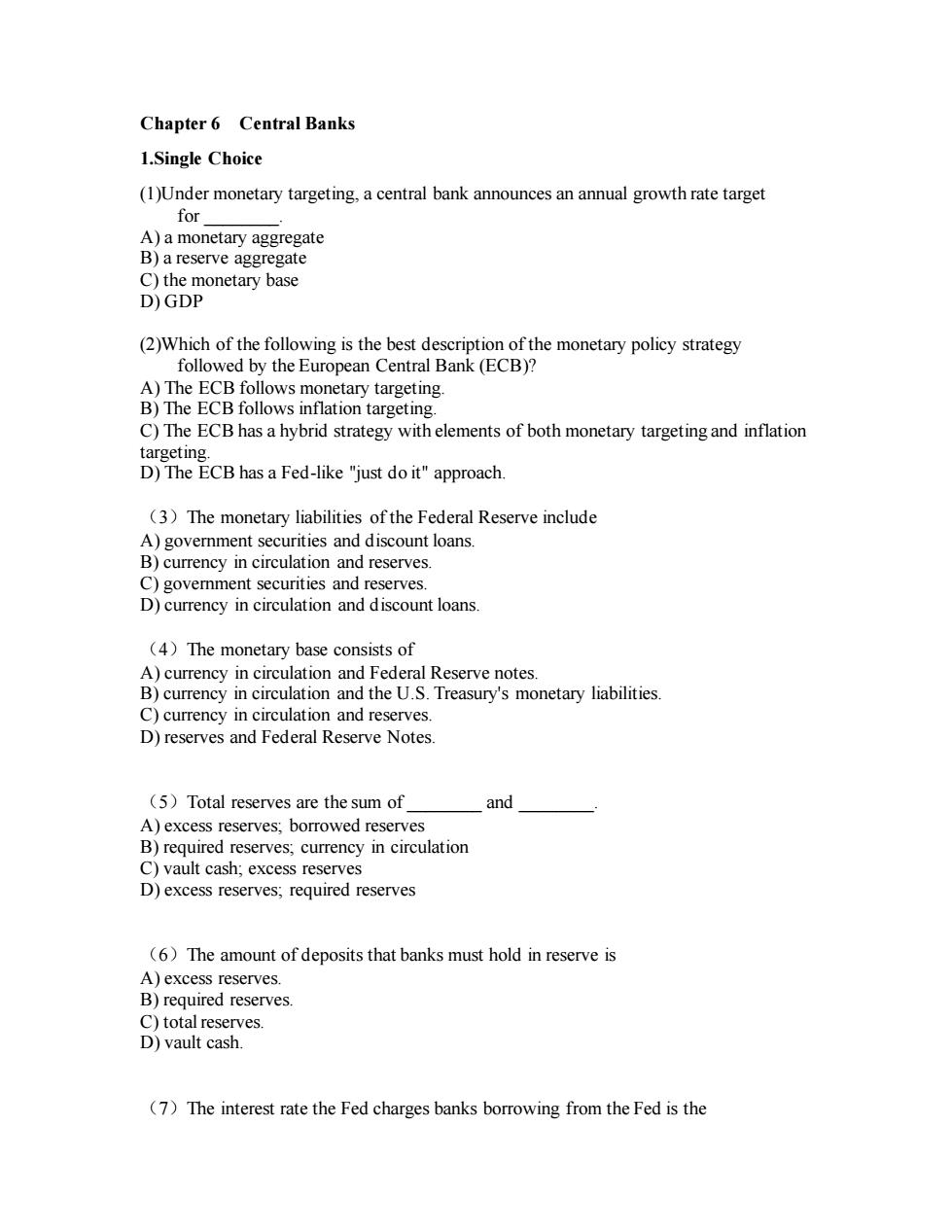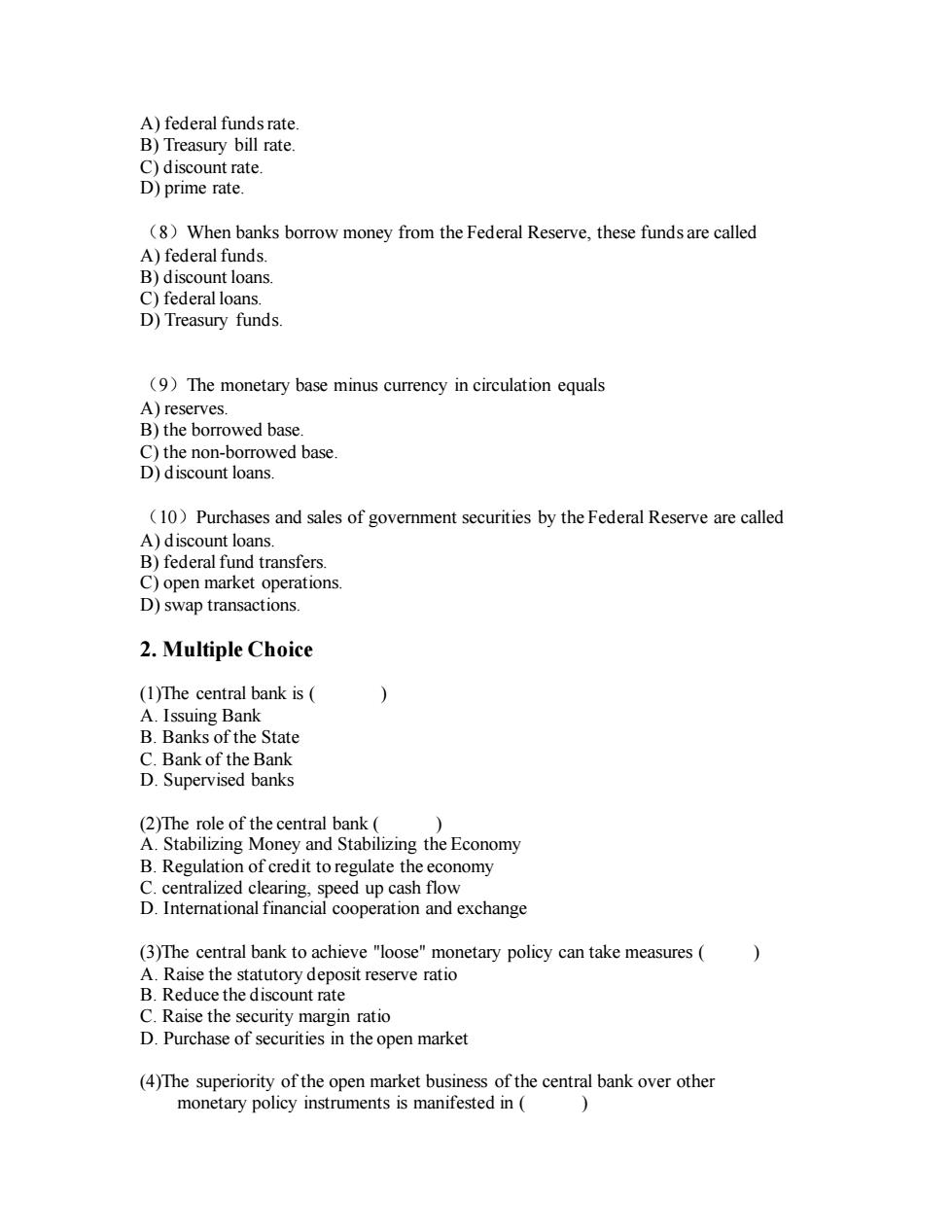
Chapter 6 Central Banks 1.Single Choice (1)Under monetary targeting,a central bank announces an annual growth rate target for A)a monetary aggregate B)a reserve aggregate C)the monetary base D)GDP (2)Which of the following is the best description of the monetary policy strategy followed by the European Central Bank(ECB)? A)The ECB follows monetary targeting. B)The ECB follows inflation targeting. C)The ECB has a hybrid strategy with elements of both monetary targeting and inflation targeting. D)The ECB has a Fed-like "just do it"approach. (3)The monetary liabilities of the Federal Reserve include A)government securities and discount loans. B)currency in circulation and reserves C)government securities and reserves. D)currency in circulation and discount loans. (4)The monetary base consists of A)currency in circulation and Federal Reserve notes. B)currency in circulation and the U.S.Treasury's monetary liabilities. C)currency in circulation and reserves. D)reserves and Federal Reserve Notes. (5)Total reserves are the sum of and A)excess reserves;borrowed reserves B)required reserves;currency in circulation C)vault cash;excess reserves D)excess reserves;required reserves (6)The amount of deposits that banks must hold in reserve is A)excess reserves. B)required reserves. C)total reserves. D)vault cash. (7)The interest rate the Fed charges banks borrowing from the Fed is the
Chapter 6 Central Banks 1.Single Choice (1)Under monetary targeting, a central bank announces an annual growth rate target for ________. A) a monetary aggregate B) a reserve aggregate C) the monetary base D) GDP (2)Which of the following is the best description of the monetary policy strategy followed by the European Central Bank (ECB)? A) The ECB follows monetary targeting. B) The ECB follows inflation targeting. C) The ECB has a hybrid strategy with elements of both monetary targeting and inflation targeting. D) The ECB has a Fed-like "just do it" approach. (3)The monetary liabilities of the Federal Reserve include A) government securities and discount loans. B) currency in circulation and reserves. C) government securities and reserves. D) currency in circulation and discount loans. (4)The monetary base consists of A) currency in circulation and Federal Reserve notes. B) currency in circulation and the U.S. Treasury's monetary liabilities. C) currency in circulation and reserves. D) reserves and Federal Reserve Notes. (5)Total reserves are the sum of ________ and ________. A) excess reserves; borrowed reserves B) required reserves; currency in circulation C) vault cash; excess reserves D) excess reserves; required reserves (6)The amount of deposits that banks must hold in reserve is A) excess reserves. B) required reserves. C) total reserves. D) vault cash. (7)The interest rate the Fed charges banks borrowing from the Fed is the

A)federal funds rate B)Treasury bill rate. C)discount rate. D)prime rate. (8)When banks borrow money from the Federal Reserve,these funds are called A)federal funds. B)discount loans C)federal loans. D)Treasury funds. (9)The monetary base minus currency in circulation equals A)reserves. B)the borrowed base. C)the non-borrowed base. D)discount loans. (10)Purchases and sales of government securities by the Federal Reserve are called A)discount loans. B)federal fund transfers. C)open market operations. D)swap transactions. 2.Multiple Choice (1)The central bank is A.Issuing Bank B.Banks of the State C.Bank of the Bank D.Supervised banks (2)The role of the central bank( A.Stabilizing Money and Stabilizing the Economy B.Regulation of credit to regulate the economy C.centralized clearing,speed up cash flow D.International financial cooperation and exchange (3)The central bank to achieve "loose"monetary policy can take measures A.Raise the statutory deposit reserve ratio B.Reduce the discount rate C.Raise the security margin ratio D.Purchase of securities in the open market (4)The superiority of the open market business of the central bank over other monetary policy instruments is manifested in (
A) federal funds rate. B) Treasury bill rate. C) discount rate. D) prime rate. (8)When banks borrow money from the Federal Reserve, these funds are called A) federal funds. B) discount loans. C) federal loans. D) Treasury funds. (9)The monetary base minus currency in circulation equals A) reserves. B) the borrowed base. C) the non-borrowed base. D) discount loans. (10)Purchases and sales of government securities by the Federal Reserve are called A) discount loans. B) federal fund transfers. C) open market operations. D) swap transactions. 2. Multiple Choice (1)The central bank is ( ) A. Issuing Bank B. Banks of the State C. Bank of the Bank D. Supervised banks (2)The role of the central bank ( ) A. Stabilizing Money and Stabilizing the Economy B. Regulation of credit to regulate the economy C. centralized clearing, speed up cash flow D. International financial cooperation and exchange (3)The central bank to achieve "loose" monetary policy can take measures ( ) A. Raise the statutory deposit reserve ratio B. Reduce the discount rate C. Raise the security margin ratio D. Purchase of securities in the open market (4)The superiority of the open market business of the central bank over other monetary policy instruments is manifested in ( )

A.Direct and strong B.initiative is good C.strong force D.Flexibility is good (5)The central bank's'bank of the bank'function is embodied in the() A.Centralized deposit preparation B.Financial regulation C.The ultimate lender D.Organize nationwide liquidation 3,ShortAnswer Questions (1)Explain the principles for issuing currency? (2)What has determined the type of central banks?
A. Direct and strong B. initiative is good C. strong force D. Flexibility is good (5)The central bank's 'bank of the bank' function is embodied in the ( ) A. Centralized deposit preparation B. Financial regulation C. The ultimate lender D. Organize nationwide liquidation 3、Short Answer Questions (1)Explain the principles for issuing currency? (2) What has determined the type of central banks?